人教版新目标英语八年级上unit6说课稿
人教版八年级英语上unit6说课稿

人教版八年级英语上unit6说课稿人教版八年级英语上册Unit 6 I am going to study computer science说课稿各位老师,大家下午好:今天我所说课的内容选自人教版初中英语新目标八年级(上)Unit 6 I’m going to study computer science中的Section A (1a-1c) .下面我将从说教材、说教法、说学法、说教学过程以及说板书设计五个方面来说说本节课的教学设计。
一、说教材:a. 教材的地位及作用:本节课是这个单元的第一课时,其主要内容是学习用be going to 谈论理想的职业。
本课时的学习是为后面Section B及一般将来时的学习做铺垫,所以它在教材中起着承上启下的作用。
通过本节课的学习学生要能对be going to表示“将来”这一结构有一个基本的了解,并能初步运用这个结构进行交谈。
本堂课所学内容与学生的实际生活密切息相关,易于提高学生的学习兴趣。
结合第六单元的教材内容,我制定如下的教学目标:b、教学目标:1)知识目标:词汇:engineer、pilot、computer programmer、violinist、pianist、actor、basketball player、driver等句型: ─What do you want to be when you grow up?─I want to be a\\an.....─How are you going to do that?─I’m going to...语法:一般将来时(be going to+动词原形)2)能力目标:能用一般将来时态表达将要做的事情。
能初步运用所学的目标语言谈论自己喜欢的职业,进一步提高听说读写的能力3)情感目标:本节课通过对职业的谈论和学习,让学生有一个自己的目标和计划,并对能他们的梦想有个积极的态度。
c、教学重、难点:1)重点:掌握本节课中表示职业的新词汇和句型,学生根据自己喜欢的职业,运用所学知识谈论自己打算怎样做来实现目标一般将来时中be going to的用法2) 难点:一般将来时be going to 中be 的具体形式和后面接动词原形的用法学生容易混淆.二、说教法为了顺利地完成教学目标,更好地突出重点、突破难点,我重点采用任务型教学法,听说法,将布置任务进行小组交流活动贯穿整堂课。
新目标英语8年级上册全英文说课稿 Unit 6

Unit 6 Section A Grade Eight 《GO FOR IT》Good morning, everyone. My name is Wuxuejun from Yucai Middle school in Longjiang county. Now I’ll talk about how to teach Section A of Unit 6 in Go For It for the students of Grade Eight. I’ll say it in four parts.I、Analysis of teaching materialII、Teaching methodsIII、Guide of studying waysIV、Teaching precedure.Part I Analysis of the Teaching Material1. Status and FunctionThe conversation of this unit is about comparing people and personal traits. It is useful for the students. I’ll finish this section in two periods. This lesson I’ll teach Part 1, Part 2. In Part 1, all the activities introduce the simple key vocabulary and the target language. These activities can help students learn how to compare people and tell some personal traits while practicing their skills of speaking, listening, shorthand, acting. In Part 2, all the activities help students learn the difficult key vocabulary and use the target language more fluently. So it’s very important to learn this lesson well.2. Analysis of the studentsStudents of their age are very active. They have strong thirst for knowledge and like to be challenged.3. Teaching Aims and DemandsThe teaching aims and demands are established according to Junior School English syllabus’ provision and the teaching material.(1) Knowledge Object:Simple key vocabulary: calm, wild, thin, heavy, than.Difficult key vocabulary: smart, outgoing, athletic.Target language: Is this Sam?No, that’s Tom. He has shorter hair than Sam.And he’s calmer than Sam(2) Ability ObjectTo train the students’ ability of listening, speaking, reading, and writing.To train the students’ ability of shorthand, acting, thinking, conclusion, etc.(3)Moral ObjectEveryone has its own traits, whether you like or not, you should show respect and find their beauties.4. Teaching ImportanceTo master the key vocabularyTo understand and use the target languageTo master the grammar of adjective and comparative adjective5. Teaching Difficulties.To enable the students to understand that they are the sentence patterns to talk about personal traits and compare people. To enable the students to use the target language.6. Teaching AidsMulti-media computer, school things and so on. They will be needed in this lessonPart II The Teaching Methods1. Communicative teaching method2. Audio-visual teaching method3.”Task-based”teaching methodAs we all know: the main instructional aims of learning English in the Middle School is to cultivate students’ abilities of listening, speaking, reading, writing and their good sense of the English language. So in this lesson I’ll mainly use “Communicative” teaching method,”Audio-visual” teaching method and “Task-base d” teaching method.That is to say, I’ll let the students to get a better understanding of the target language, master the vocabulary and grammar better. I’ll give the students some tasks and arrange several kinds of activities: watching pictures, writing, listening, making conversations, acting, group work and so onTeaching special features: To use these methods is helpful to interest students and develop their thoughts.Part III Studying ways1. Let the students master the key vocabulary better by guessing, acting, listening, using.2. Enable the students study English language by Communicating, Describing, Listening.3. Let the students understand the grammar well by summarizing the grammar rules by themselves. Part IV Teaching ProcedureStep 1 Warm up:Show a picture of Yaoming and a picture of a man, and say Yaoming is taller than him. Then give another picture, let them find the differences. While the student want to express their thought in English ,and they do not have learned the expressions, raise their desire for learning this part of knowledge.(purpose: To attract the student s’ attention and to create a relaxed atmosphere.)Then, show the students the goals :1.We must master the words in section A.2. We can use the adjective and comparative adjective to describe a person.Step2.Check oneLet the studengts do 1a. Practise the target language with long hair and tall. Students are allowed to speak slowly at the first time and a little faster at the second time.This part, I give the student the chance to practice the target language. Improve their speaking skills with comparative adjective.(Purpose: To begin with the review of adjective can enable the students easily master the key points including its regular information and irregular one as well as to learn to make statements by choosing the right adjectives.)Step3. Practice listening 1b—2bListen to the tape, and shorthand the key words. Then, write down the main information in the form of using the target language according to their own shorthand notes. When all have done with the work, I’ll give them the correct answers. And once again I will tell them the skills of shorthand. As shorthand is a useful skill in listening comprehension and modern society, students can learn and practise it from now on.(Purpose: In order to improve students’ listening and writing skills,by playing the recording of the text and repeating,students can further consolidate what they have just learned.)Step4.Performance and communicationDeskmates make a group. Let them act the dialogue with the information in the chart on page 81.Acting makes students understand the meaning of the key vocabulary better and attract the whole class. Making a conversation while some are acting, gives the student the chance to communicate with each other. Repeating the dialogues not only helps the rest of students’ discipline but also makes them practice the target language as well. Grading their own performance is a new way and will make the students try their best to perform well.(Purpose: Through comparison of description of parnter’s appearance and personality can easily arouse students’ learning desire and interests. So they can master difficulties and key points of the text and describe others well.)Step5 ConsolidationDiscuss the two people in the picture. Which one do you like better? why? Then, gradually let them understand we should respect everyone, because every one has its good merits and shortcoming. We should find people’s beauties not only look at their short comings. Good teachers teach not only the students knowledge, but also how to be a man and behave.Write the 3 lists of adjective and comparative adjective are on the blackboard, let one in each group summary the regualaries.It comes to grammar teaching. This part, students are trained to use their own wit to summarize some principles. It is designed to gain points, and students’ wit is cha llenged, so this activity willra ise the students’ interest.Step 6 Check TwoCover the blackboard for 30seconds, and let the students close their eyes and review what they have just learnt. Make a better use of the difficulties and important information on the blackboard. Reviewing at the end of the class can help students’ memory, This part also practice the reading ability and check the pronunciation.Step7 Homework .Make a list of top 10 obvious traits or comparison about your best friend or your parents. When it comes to the homework part, teachers should have enough time to explain their assignment clearly to avoid misunderstanding of demands. At the meantime, the teacher can give students some advice to finish their homework efficiently. Homework which is related to the students’ life can surely trigger their interest to finish the homework earnestly. The homework can help the students to consolidate the target language and train their writing ability.(Purpose: it’s necessary for students to do some extensive exercise after class to consolidate the knowledge they learnt.)Step 8 Blackboard designUnit 6 I’m more outgoing than my sister-er -ier more ~ -Is that Sam?calm-calmer funny-funnier athletic-more athletic -No, that’s Tom, he has shorter hairtall-taller heavy-heavier outgoing-more outgoing than Sam. And he’s calmer than Sam smart-smarter happy-happier interesting-more interestingwild-wilder thin-thinner。
人教版新目标英语八年级上unit6说课稿
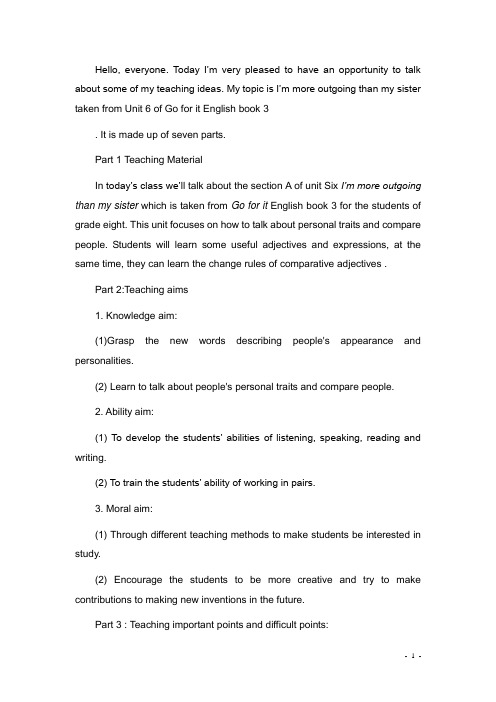
Hello, everyone. Today I’m very pleased to have an opportunity to talk about some of my teaching ideas. My topic is I’m more outgoing than my sister taken from Unit 6 of Go for it English book 3. It is made up of seven parts.Part 1 Teaching MaterialIn today’s class we’ll talk about the section A of unit Six I’m more outgoing than my sister which is taken from Go for it English book 3 for the students of grade eight. This unit focuses on how to talk about personal traits and compare people. Students will learn some useful adjectives and expressions, at the same time, they can learn the change rules of comparative adjectives .Part 2:Teaching aims1. Knowledge aim:(1)Grasp the new words describing people's appearance and personalities.(2) Learn to talk about people's personal traits and compare people.2. Ability aim:(1) To develop the students’ abilities of listening, speaking, reading and writing.(2) To train the students’ ability of working in pairs.3. Moral aim:(1) Through different teaching methods to make students be interested in study.(2) Encourage the students to be more creative and try to make contributions to making new inventions in the future.Part 3 : Teaching important points and difficult points:1. Key points(1). Grasp the new words and phrases: calm, serious, smart, outgoing, athletic, twin, wild, more than, be good at(2).new structureSubject +be+ comparative degree+ than+ … …2. Difficult points(1).How to change adjective into comparative adjectives .(2).How to talk about personal traitsPart 4 : Teaching Aids1. Blackboard2. Chalk3. PPT4. The MultimediaPart 5 : Teaching MethodsBefore dealing with this lesson, I’ll do my best to carry out the following theories: Make the Ss the real masters in class while the teacher himself acts as director;Combine the language structures with the language functions; Let the students receive some moral education while they are learning the English language. In this period, I’ll try to use three methods.Teaching method:Situational teaching methodCommunicative teaching methodTask-based teaching methodPart 6: Teaching procedureI have designed the following steps to train their ability of listening, speaking, reading and writing.The entire steps are:Lead-in, preparation, pair work, practice, summary and homeworkStep 1 Lead-inShow them some pictures and let them talk with each other, compare the pictures and find the differences between these pictures. For example, these two women ,which is thin, while the other is heavy. The other two pictures show that the girl is short and the boy is tall. In this way, we can lead to our topic today.Step 2: presentationThere are three parts in this step.First, In this part we will learn some new words /phrases, and cultivate the students’ ability of speaking and reading. The new words are outgoing, twin, calm, wild, serious, smart, athletic, note and so on .Second, I will lead the students to learn the dialogues ,and master the useful phrases and expressions .——Is that Sam?——No, that’s Tom. He has shorter hair than Sam .And the main structure we learn today is Subject + be + comparative degree + than+ … …Third, I will teach the student the change rule of comparative adjectives.Step 3: Pair workStudent A and Student B ,look at the chart.Then ask and answer the question about Tina and Tara.Step 4: PracticeIn this part, there are some choice questions. I will ask some students to answer the questions. In this way, I can check the students what they have learned in this class.Step 5: SummaryIn this part, I will review the new words and the main structure and how to use the change rules of comparative adjectives.Step 6: HomeworkWriting: Think of yourself two years ago. Write about how you are different now.Part 7: Blackboard DesignUnit 6 I’m m ore outgoing than my sister1、Word :outgoing twin calm wild serious smart athletic note mean more than in common be good at2、… … be +adj.比较级+than +… …At the end of the class, I will show two sentences about friendship and I want to the students can really know what these two sentences mean .。
英语人教版八年级上册Unit6说课稿

英语人教版八年级上册Unit6说课稿Unit 6 I’m going to study computer science.(Period1)说课稿一、教材分析:本单元的教学内容是人教版新目标八年级上Unit 6 I’m going to study computer science Section A的第一课时1a-2a , 是本单元的第一部分,主要内容是学习关于职业的单词以及be going to 的用法,用一般将来时谈论未来自己和他人理想的职业,为实现理想做出的打算和安排,目的是通过对人生理想的讨论使学生不仅对未来的憧憬,而且要从现在起为自己的理想而奋斗。
二、总体目标:1、知识目标:学习以下词汇,并要求学生能熟练运用。
computer programmer, engineer, bus driver, cook, pilot, scientist, violinist, pianist2、能力目标:要求学生熟练运用以下句型来谈论未来自己理想的职业,为实现理想做出的打算和安排,提高学生综合运用语言的能力。
A: What do you want to be when you grow up?B: I am going to be a/an…A: How are you going to do that ?B: I’m going to …3、情感目标:激发学生们的学习主动性和学习兴趣,使他们更加有理想,并为实现自己的理想而不断努力。
三、教学重难点:1) 学习一般将来时态的构成方式。
2) 学习本课时出现的重点句型,通过在不同情景下运用来熟练运用一般将来时态。
四、学情分析:本次教学面对的是普班学生,他们基础普遍薄弱,对学习没有很大信心。
所以本次教学中练习比较多,突出学生为主体,引导他们对未来生活的憧憬,培养学习英语的信心。
五、教学策略选择与设计基础英语阶段课程的目标是以学生语言技能、语言知识、情感态度、学习策略和文化意识的发展为基础,培养学生英语综合语言运用能力,让学生在教师的指导下,通过感知、体验、实践、参与和合作等方式,实现学习目标,感受成功。
人教版八年级英语上册说课稿UNIT 6 Period 1 (Section A 1a-2c)

人教版八年级英语上册说课稿UNIT 6 Period 1 (Section A 1a-2c)一. 教材分析人教版八年级英语上册Unit 6 Period 1(Section A 1a-2c)的主要内容是关于野生动物的保护。
通过本节课的学习,学生可以掌握野生动物的名称以及保护野生动物的重要性。
本节课的主要语言点是野生动物的名称和形容词比较级。
本节课旨在提高学生的语言运用能力,培养学生的环保意识。
二. 学情分析八年级的学生已经掌握了基本的英语语法和词汇,具备一定的英语听说读写能力。
但是,对于某些野生动物的名称和保护野生动物的重要性可能还不够了解。
因此,在教学过程中,教师需要帮助学生建立起新的语言知识结构,提高他们的语言运用能力,同时也要注重培养他们的环保意识。
三. 说教学目标1.知识目标:学生能够掌握Section A 1a-2c中关于野生动物的名称和形容词比较级。
2.能力目标:学生能够在真实情境中运用所学语言知识进行交流。
3.情感目标:学生能够认识到保护野生动物的重要性,培养环保意识。
四. 说教学重难点1.重点:学生能够掌握野生动物的名称和形容词比较级。
2.难点:学生能够在真实情境中运用所学语言知识进行交流,并能够理解保护野生动物的重要性。
五. 说教学方法与手段1.交际法:通过小组讨论、角色扮演等方式,让学生在真实情境中运用所学语言知识进行交流。
2.情境教学法:通过展示野生动物的图片和视频,引导学生理解和掌握野生动物的名称和形容词比较级。
3.任务型教学法:通过完成保护野生动物的计划,培养学生的环保意识。
六. 说教学过程1.导入:教师展示一些野生动物的图片,引导学生说出这些动物的名称,为新课的学习做好铺垫。
2.新课呈现:教师通过展示野生动物的图片和视频,引导学生学习和掌握野生动物的名称和形容词比较级。
3.课堂练习:学生通过完成练习题,巩固所学知识。
4.小组讨论:学生分组讨论如何保护野生动物,并完成一个保护野生动物的计划。
新目标英语八年级上Unit6-Period1说课稿
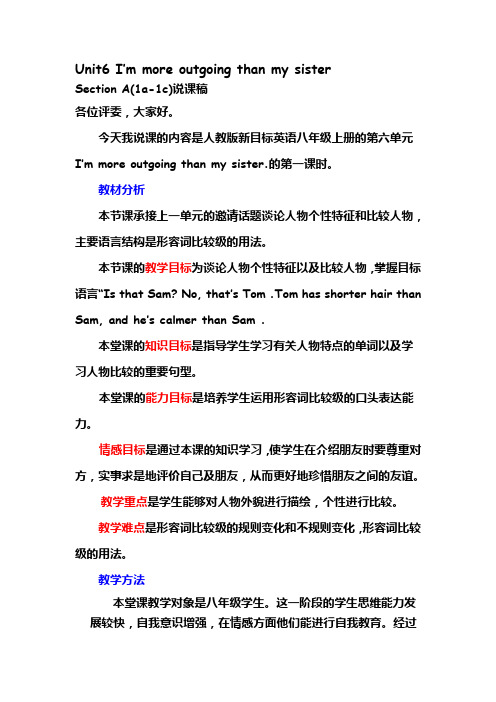
Unit6 I’m more outgoing than my sisterSection A(1a-1c)说课稿各位评委,大家好。
今天我说课的内容是人教版新目标英语八年级上册的第六单元I’m more outgoing than my sister.的第一课时。
教材分析本节课承接上一单元的邀请话题谈论人物个性特征和比较人物,主要语言结构是形容词比较级的用法。
本节课的教学目标为谈论人物个性特征以及比较人物,掌握目标语言“Is that Sam? No, t hat’s Tom .Tom has s horter hair than Sam, and he’s calmer than Sam .本堂课的知识目标是指导学生学习有关人物特点的单词以及学习人物比较的重要句型。
本堂课的能力目标是培养学生运用形容词比较级的口头表达能力。
情感目标是通过本课的知识学习,使学生在介绍朋友时要尊重对方,实事求是地评价自己及朋友,从而更好地珍惜朋友之间的友谊。
教学重点是学生能够对人物外貌进行描绘,个性进行比较。
教学难点是形容词比较级的规则变化和不规则变化,形容词比较级的用法。
教学方法本堂课教学对象是八年级学生。
这一阶段的学生思维能力发展较快,自我意识增强,在情感方面他们能进行自我教育。
经过一年的新课程理念的熏陶及实践,学生已有了初步的自主、合作、探究和实践的能力。
所以我以英语新课标为理论,根据现阶段我校学生英语教学的基本学情为依据,结合八年级学生的心理特点和认知发展规律,采用了1.听说法。
利用多媒体课件上英语课,使学生视听感受明显,激发学生的学习兴趣,并在轻松愉快的环境下学习英语。
2.课堂互动法。
通过师生交流,生生交流,实现师生互动。
鼓励学生大胆发言,营造平等交流气氛,让学生成为课堂学习的主体。
3 .直观教学法。
通过用图片展示教学生词,加深学生对单词以及形容词比较级的认识,使抽象的语言变得直观。
4.任务型教学法即按学生需要取材,由内容决定形式以及以任务为载体,以完成任务为动力。
人教版八年级英语上册Unit6SectionB2a2bResolutions说课稿

4.小组竞赛:设置与新年计划相关的竞赛活动,激发学生的合作精神和竞争意识。
四、教学过程设计
(一)导入新课
为快速吸引学生的注意力和兴趣,我将以一段关于新年计划的趣味视频作为新课导入。视频中包含学生们熟悉的场景和角色,以此激发他们的好奇心。观看视频后,我会提出以下问题:“Do you make New Year's resolutions? What are your resolutions for this year?”让学生们进行头脑风暴,分享自己的新年计划。这样的导入方式既能引发学生的思考,又能自然过渡到本节课的主题。
5.结合学生的兴趣,引入与新年计划相关的英文歌曲、电影片段等,提高学生的学习积极性。
三、教学方法与手段
(一)教学策略
我将采用任务型教学法作为主要教学方法。任务型教学法强调以学生为中心,通过完成具体的任务来促进学生的语言运用能力和交际能力。这种方法的理论依据是社会建构主义理论,认为学习是在社会互动中构建意义的。通过设置与新年计划相关的任务,如制定个人新年计划、采访同学等,学生在真实语境中运用语言,提高他们的实践能力。
3.课堂游戏:设计“新年计划”主题的接龙游戏,让学生在游戏中运用所学词汇和句型;
4.书面练习:布置一篇关于新年计划的短文写作,要求学生运用一般现在时态进行描述。
-能够运用所学知识表达自己的新年计划及决心;
-提高学的听说读写能力,为日常交流奠定基础。
2.过程与方法:
-通过小组讨论、角色扮演等教学活动,培养学生的合作意识和解决问题的能力;
-通过听力练习,提高学生的听力理解能力;
-通过口语练习,提高学生的表达能力。
3.情感态度与价值观:
人教版新目标英语八年级上册《unit 6》 英语说课稿

人教版新目标英语八年级上册《unit 6》英语说课稿人教版新目标英语八年级上册《unit 6》英语说课稿各位老师:大家好,今天我要说课的内容是初二英语上册第6单元SectionA 的前部分,Title(题目)是I`m more outing than my sister.其主要的内容是:“Talk about personal traits and how to compare people.”一话题。
由于本单元具有两部分:SectionA和SectionB,从教材的整合来说本部分即有形容词用法的延续,又为后面形容词最高级的学习打下基础,具有承上启下的作用;再则,从本单元来说它既是本单元的基本语言内容,又为本单元知识扩展和综合语言运用奠定坚实的基础。
因此,上好SectionA的前部分,既可让知识学习具有一定的延续性,又可为下面的教学做好铺垫,对完成本单元和今后的英语教学具有重要的意义。
对于SectionA前部分的教学,我准备把对词汇的掌握和听力的理解作为重点,把结对活动的核心对话(即学生说的能力培养)作为难点。
这是因为我校地处农村,学生在英语学习方面没有一个好的语言氛围,有些学生不能拥有自己的一套磁带,更不用说拥有其他的听力辅助材料,因此解决这一重点,能让学生进一步感受英语语言的美,激发他们的学习兴趣,这为突破难点作好铺垫;而难点的确立是由于本套教材的特点是采用任务型语言教学模式,融汇话题、交际功能和语言结构,形成了一套循序渐进的生活化的学习程序并结合我校“新课程与学习方式的转变”课题实践,从而突出学生参与探究活动的主体作用。
基于以上的分析,本节的教学要达到以下几个目标:在“知识目标”中,通过教学让学生掌握本课的词汇运用;“能力目标”方面:指导学生在自主探究和任务型教学模式中,让学生学会用英语与他人谈论人的个性特征和形容词的比较的话题,以及进一步提高听力能力和英语语言表达能力;“情感、态度、价值观”方面:通过师生在教学的双边活动中主动性和创造性的发挥,激发学生的学习兴趣,体验英语语言的美,体验知识间的相互应用、相互依存、联系,让学生充满自信,体验成就感和合作精神。
新目标英语八年级上册说课稿 unit 6 section a 说课稿
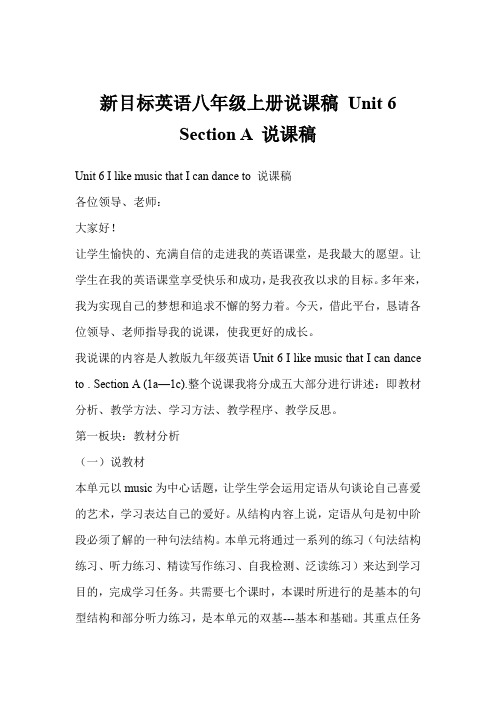
新目标英语八年级上册说课稿Unit 6Section A 说课稿Unit 6 I like music that I can dance to 说课稿各位领导、老师:大家好!让学生愉快的、充满自信的走进我的英语课堂,是我最大的愿望。
让学生在我的英语课堂享受快乐和成功,是我孜孜以求的目标。
多年来,我为实现自己的梦想和追求不懈的努力着。
今天,借此平台,恳请各位领导、老师指导我的说课,使我更好的成长。
我说课的内容是人教版九年级英语Unit 6 I like music that I can dance to . Section A (1a—1c).整个说课我将分成五大部分进行讲述:即教材分析、教学方法、学习方法、教学程序、教学反思。
第一板块:教材分析(一)说教材本单元以music为中心话题,让学生学会运用定语从句谈论自己喜爱的艺术,学习表达自己的爱好。
从结构内容上说,定语从句是初中阶段必须了解的一种句法结构。
本单元将通过一系列的练习(句法结构练习、听力练习、精读写作练习、自我检测、泛读练习)来达到学习目的,完成学习任务。
共需要七个课时,本课时所进行的是基本的句型结构和部分听力练习,是本单元的双基---基本和基础。
其重点任务是导入新的语言即New Function Presenting .因此这一节课我分成两个部分:第一部分引入定语从句的学习:第二部分围绕I like music that I can dance to .这一话题展开思维(1a)、听力(1b)、口语(1c)训练进行授课,最终完成本课时的教学任务。
(二)教学目标根据《英语课程标准》的教学理念,教材特点以及学生的实际情况,将本课时的教学目标确定如下:1 Knowledge objects(1) Key vocabulary prefer ,lyric(2) Target language What kind of music do you like ? I like music that I can dance to . . What about you ? I prefer music that has great lyrics.2 Ability objects(1) Train students to express preferences(2) Train students’listening skills3 Moral objectsLet’s enjoy music .Let’s enjoy ourselves. Let’s enjoy life.教学重点(1) Key V ocabulary prefer , lyric (2) Target language (四) 教学难点(1) Attributive clauses with that/who . (2) The listening practice .第二板块:教学方法由于英语是一门综合性与实践性相结合的科目,根据本文内容,综合到新教育理论,本课主要采用任务型教学法,情景教学法以及多媒体辅助教学,充分发挥教师的主导作用和学生的主体地位。
【人教版】新目标八年级英语上册:Unit6单元说课稿

【人教版】新目标八年级英语上册:Unit6单元说课稿一. 教材分析人教版新目标八年级英语上册Unit6主要围绕着“节日”这一主题展开,通过学习本单元,学生能够掌握关于节日的词汇和表达方式,了解不同国家的节日习俗,提高自己的跨文化交际能力。
教材内容丰富,包括主课文、语法、听说、读写等多个部分,旨在全面提升学生的英语综合运用能力。
二. 学情分析八年级的学生已经具备了一定的英语基础,对于学习新的词汇和表达方式有一定的掌握。
但同时,学生在语法、听说、读写等方面的能力参差不齐,需要针对性地进行教学设计。
此外,学生对于不同国家的文化背景了解有限,需要通过课堂拓展来提高他们的跨文化交际意识。
三. 说教学目标1.知识目标:学生能够掌握关于节日的词汇和表达方式,了解不同国家的节日习俗。
2.能力目标:学生能够运用所学知识进行简单的跨文化交际,提高自己的英语口语表达能力。
3.情感目标:培养学生对不同文化的尊重和理解,拓宽国际视野。
四. 说教学重难点1.重点:掌握关于节日的词汇和表达方式,了解不同国家的节日习俗。
2.难点:运用所学知识进行实际的跨文化交际,提高英语口语表达能力。
五. 说教学方法与手段1.交际法:通过模拟真实场景,让学生在实际语境中运用所学知识进行交流。
2.任务型教学法:通过完成各种任务,激发学生的学习兴趣,提高他们的实践能力。
3.多媒体教学手段:运用PPT、视频等教学辅助材料,丰富课堂形式,提高学生的学习积极性。
六. 说教学过程1.导入:以一段关于节日的视频导入,激发学生的学习兴趣,同时引导学生思考:你们知道哪些节日?最喜欢哪个节日?2.新课呈现:通过PPT展示本节课的主要内容,包括节日词汇和表达方式,不同国家的节日习俗等。
3.课堂实践:模拟真实场景,让学生分组进行角色扮演,运用所学知识进行跨文化交际。
4.语法讲解:针对本节课的语法点,进行详细的讲解和示例,让学生在理解的基础上进行运用。
5.听力训练:播放一段关于节日的听力材料,学生听后进行问答,检查学生对听力材料的理解程度。
新目标英语八年级上册Unit6 Section B说课稿
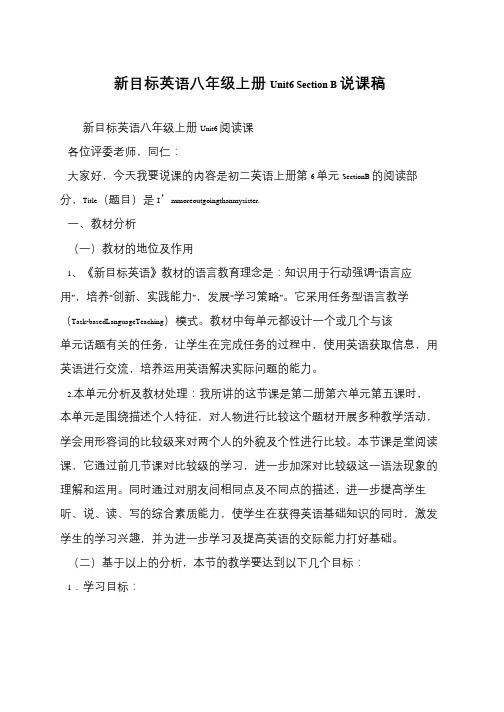
新目标英语八年级上册Unit6 Section B 说课稿
新目标英语八年级上册Unit6 阅读课
各位评委老师,同仁:
大家好,今天我要说课的内容是初二英语上册第6 单元SectionB 的阅读部分,Title(题目)是I’mmoreoutgoingthanmysister.
一、教材分析
(一)教材的地位及作用
1、《新目标英语》教材的语言教育理念是:知识用于行动强调“语言应用”,培养“创新、实践能力”,发展“学习策略”。
它采用任务型语言教学(Task-basedLanguageTeaching)模式。
教材中每单元都设计一个或几个与该
单元话题有关的任务,让学生在完成任务的过程中,使用英语获取信息,用英语进行交流,培养运用英语解决实际问题的能力。
2.本单元分析及教材处理:我所讲的这节课是第二册第六单元第五课时,本单元是围绕描述个人特征,对人物进行比较这个题材开展多种教学活动,学会用形容词的比较级来对两个人的外貌及个性进行比较。
本节课是堂阅读课,它通过前几节课对比较级的学习,进一步加深对比较级这一语法现象的理解和运用。
同时通过对朋友间相同点及不同点的描述,进一步提高学生听、说、读、写的综合素质能力,使学生在获得英语基础知识的同时,激发学生的学习兴趣,并为进一步学习及提高英语的交际能力打好基础。
(二)基于以上的分析,本节的教学要达到以下几个目标:
1.学习目标:。
Unit6 I'm going to study computer science说课稿

课题人教版八年级上册英语Unit6I'm going to study computer scienceSection B 2a-2e 说课稿班级备课教师课型第5课时课时1尊敬的各位评委老师:大家好!今天我说课的内容是人教八年级上册Unit6I'm going to study computer science Section B2a-2e。
下面我将从说教材、说学情、说教学目标、说教学重难点、说教法、说学法、说教学过程以及说板书设计这八个方面来展开我的说课。
一、说教材本单元的主题是“Future plans and intentions(未来的计划和意图)”,Section B2a-2e部分围绕“New Year's resolutions(新年决心)”这一话题展开阅读教学。
通过这部分的学习,学生能够进一步巩固和拓展关于未来计划的表达方式,提高阅读技巧和理解能力,同时引导学生思考如何制定并实现自己的目标。
二、说学情八年级的学生已经具备了一定的英语基础知识和阅读能力,但对于较复杂的阅读文本可能还存在理解上的困难。
他们对未来充满憧憬和期待,对新年决心这一话题会有较强的兴趣和参与度。
三、说教学目标1.知识目标学生能够掌握文中的重点词汇和短语,如resolution,promise,improve,physical,self-improvement等。
学生能够理解文章的主要内容,了解新年决心的含义、种类和人们制定新年决心的原因。
2.技能目标培养学生的阅读技巧,如略读、寻读、概括段落大意等。
提高学生的语言运用能力,能够用英语表达自己的新年决心和计划。
3.情感目标引导学生树立正确的目标意识,鼓励他们为实现自己的目标而努力奋斗。
四、说教学重难点1.教学重点理解文章内容,掌握重点词汇和短语。
培养学生的阅读技巧,能够概括段落大意。
2.教学难点如何引导学生用英语表达自己的观点和想法,制定合理的新年决心和计划。
人教版英语八年级上第6单元英文说课稿

人教版英语八年级上第6单元英文说课稿Unit 6 It’s raining!Page 35 Section B 3a~4Good morning, everyone. I’m glad to stand here to share my ideas about the lesson with you. I hope that you will give me some advice for my presentation. I will analyze the lesson from the six aspects:analysis of teaching material, studentanalysis, teaching methods, learning methods, procedures and blackboard design. Part One :Analysis of teaching material1 .Status And FunctionThis unit focus on a very interesting topic—Will people have robots? it can raiselearning interest of students and it’s also helpful to improvetheir spoken English.2. Teaching Aims and Demandsnowledge Objects: K(1)The first one, students can listen, read, say and spell the new words and phrases.(2) The second one is to know the usage of some phrases.Avility Objects(1)To improve the ability of getting information by reading.(2)To develope the ability of speaking and writing, and the abilityof working in groups and communication..Moral Object :3. Teaching Key Points1(To help Ss communicate with each other using the new sentence pattern.2(To enable Ss to study in groups and co-operate skillfully.3. To develop Ss’interest in English. I think, it’s the most important .4.Teaching DifficultiesI think the most difficult point is to make sure the Ss use the sentence pattern correctly and to finish the task by themselves.Part Two Analysis of studentsSs have learned the Present Progressive Tense in the last unit. They can understand some words and some simple sentences. And ,this lesson are about weather and what people usually do in the different weather. It’s related to our daily life,so Ss must havetaken a great interest in this lesson now.Part Three Teaching methodsIn this topic,I will use Task-based Method, Communicative Method, Group Co-operate method. I think if I want to improve the students’ oral English,I should give them enough chances to practice and I will use pair work,group work to let the students take an active part in all kinds of activities.That is “Learning bydoing,learning by using”.Part Four Teaching ProceduresStep 1 Lead-inThe purpose is to arouse the students’ interest of study. I’lltalk about dreams with students for minutes. What jobs do you want to have in the future? A doctor or an actor? Maybe some boys want to be soldiers? Do you want to work as a journalist? OK, if you are a journalist and you want to give a report, how can you express yourself clearly? Now there is a report on our book, please turn to Page 35.Step2 PresentationFirst let’s look at the new words. Show the new words of Page 35 on the screen. Read them and students repeat. At the same time, talk about the Chinese meaning together.Step3 3a1.Now turn to Page 35.Look at 3a. This is a report. Yuan Yuan is reporting for CCTV’s Around The World show. She talks about the things from several aspects. Ask students to read the report loudly and I’ll divide the students into groups of 4people. Talk about the questions on the blackboard with their partner. Write the questions on the blackboard. Thanks:(what does she thank for?) When:(when does the thing happened?)Where:(where is it?) Weather:(what’s the weather like?) Who:(whoare there?) Why:(why are they there?) What:(what are they doing?)su rprised: (what are they surprised for?)summary:(what’s the summary of the report?)In a while, ask the presenter of each group answer the questions. W rite the best answer on the blackboard. The purpose is to develop the skills of skimming and how to gain the different information of the articles. And their ability of co-operation will be well trained.2.Then go back to the question in the title. Underline the things that people are doing. Circle the words that describe the weather.We’ll do the job on th e blackboardtogether.3.Next we read the report carefully and talk about the grammarpoints in it. Show the grammar points on the screen. By this way, students can comprehensive the article better. And it’s also helpful to improve the writing skills of students.Step4 3bLook at the pictures of France. Encourage students to describe the pictures by themselves. Don’t be worried about making mistakes. Ask several students to show their description to the whole class. The purpose is to improve students’ o ral English.Then fill in the blanks. Try to finish it by themselves. Check the answer on the blackboard . Read the article and translate it for the whole class at last.tep5 Survey SIn this part, I’ll ask students to practice the conversation in pairs. Ask your classmates what they do in different kinds of weather. Make a list.eg. A: What do you usually do when it’s raining?B: I usually read a book.A: What do you usually do when it’s sunny?B: I usually swim in a river.By this way, students can get enough chance to practice their oral English and develop students’ interest of English.Step6 SummaryDuring my teaching,I’ll try my best to get my class alive and encourage the studentsto talk with each other in English.I think the general aim of English teaching is to improve the ability of using English. And I’ll teach students the writing skills in a lively way. Make the students to love the interesting English and the lovely English teacher.Part7 HomeworkRecite the article of 3a and write an article about what the weather is like in your hometown and what the people are doing.。
英语Unit 6《I'm more outgoing than my sisiter.》说课稿(人教版八上)
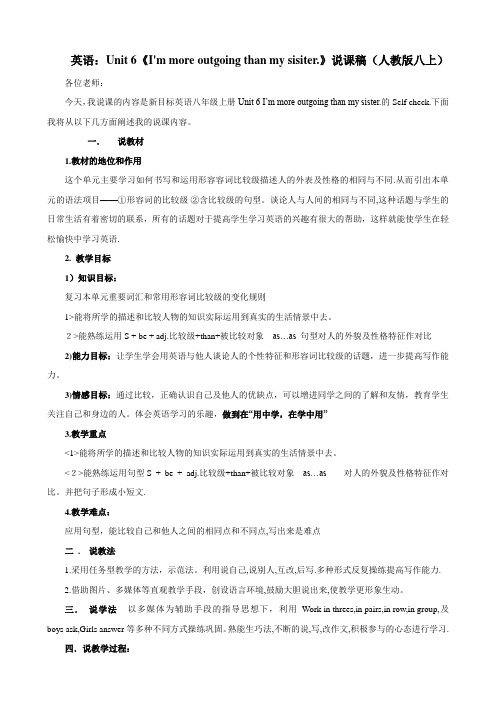
英语:Unit 6《I'm more outgoing than my sisiter.》说课稿(人教版八上)各位老师:今天,我说课的内容是新目标英语八年级上册Unit 6 I’m more outgoing than my sister.的Self check.下面我将从以下几方面阐述我的说课内容。
一.说教材1.教材的地位和作用这个单元主要学习如何书写和运用形容容词比较级描述人的外表及性格的相同与不同.从而引出本单元的语法项目——①形容词的比较级②含比较级的句型。
谈论人与人间的相同与不同,这种话题与学生的日常生活有着密切的联系,所有的话题对于提高学生学习英语的兴趣有很大的帮助,这样就能使学生在轻松愉快中学习英语.2. 教学目标1)知识目标:复习本单元重要词汇和常用形容词比较级的变化规则1>能将所学的描述和比较人物的知识实际运用到真实的生活情景中去。
2>能熟练运用S + be + adj.比较级+than+被比较对象as…as 句型对人的外貌及性格特征作对比2)能力目标:让学生学会用英语与他人谈论人的个性特征和形容词比较级的话题,进一步提高写作能力。
3)情感目标:通过比较,正确认识自己及他人的优缺点,可以增进同学之间的了解和友情,教育学生关注自己和身边的人。
体会英语学习的乐趣,做到在“用中学,在学中用”3.教学重点<1>能将所学的描述和比较人物的知识实际运用到真实的生活情景中去。
<2>能熟练运用句型S + be + adj.比较级+than+被比较对象as…as 对人的外貌及性格特征作对比。
并把句子形成小短文.4.教学难点:应用句型,能比较自己和他人之间的相同点和不同点,写出来是难点二. 说教法1.采用任务型教学的方法,示范法。
利用说自己,说别人,互改,后写.多种形式反复操练提高写作能力.2.借助图片、多媒体等直观教学手段,创设语言环境,鼓励大胆说出来,使教学更形象生动。
英语人教版八年级上册unit6说课稿及反思
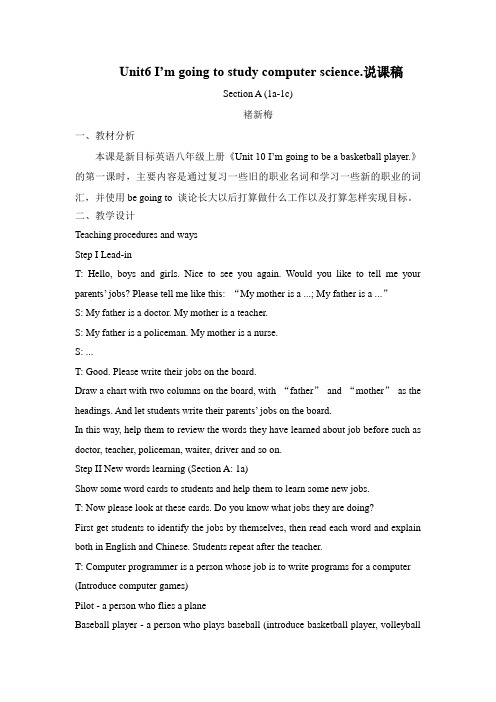
Unit6 I’m going to study computer science.说课稿Section A (1a-1c)褚新梅一、教材分析本课是新目标英语八年级上册《Unit 10 I’m going to be a basketball player.》的第一课时,主要内容是通过复习一些旧的职业名词和学习一些新的职业的词汇,并使用be going to 谈论长大以后打算做什么工作以及打算怎样实现目标。
二、教学设计Teaching procedures and waysStep I Lead-inT: Hello, boys and girls. Nice to see you again. Would you like to tell me your parents’ jobs? Please tell me like this: “My mother is a ...; My father is a ...”S: My father is a doctor. My mother is a teacher.S: My father is a policeman. My mother is a nurse.S: ...T: Good. Please write their jobs on the board.Draw a chart with two columns on the board, with “father”and “mother”as the headings. And let students write their parents’ jobs on the board.In this way, help them to review the words they have learned about job before such as doctor, teacher, policeman, waiter, driver and so on.Step II New words learning (Section A: 1a)Show some word cards to students and help them to learn some new jobs.T: Now please look at these cards. Do you know what jobs they are doing?First get students to identify the jobs by themselves, then read each word and explain both in English and Chinese. Students repeat after the teacher.T: Computer programmer is a person whose job is to write programs for a computer (Introduce computer games)Pilot - a person who flies a planeBaseball player - a person who plays baseball (introduce basketball player, volleyballplayer ...)Engineer - someone whose job is to design or build roads, bridges, machines etc Actor - a man who plays a role in a play or a film or television programs (introduce actress)Ask some students to read each new word to the class, correct their pronunciations. T: Do you think these jobs are interesting? (Students may have all kinds of responses.) Now rank them please. 1 is the most interesting and 6 is the least interesting.Check their answers and find out the most interesting job in the students’ eyes.T: Who made engineer number 1? Hands up! ...Step III Function presentationT: (Ask one of the students) Would you like to be a computer programmer in the future?S: Yes. I like to be a computer programmer.T: That is to say, “You are going to be a computer programmer in the future.”(On the board)Circle “are going to” on the board.T: Tod ay we’ll learn to talk about future intentions using “be going to”. Future intention means something you want to do or plan to do in the future. Clear?Ss: Yes.T: We learned to talk about future plans using “be +v-ing” structure in unit 3. Remember? Could you give me an example?S: I’m buying a new bike. (Write on the board and circle the “-ing”word)S: —Where are you going next week?—I’m going to my grandmother’s home next week.T: Very good. We can use “be+v-ing”to talk about future events. Today we’ll talk about future intentions using “be going to”structure. Look at this sentence:I’m going to be a computer programmer when I grow up. (On the board)Circle “when I grow up” and point out that it is not a question but means time.T: Please read after me.Students repeat the sentence after the teacher. Then let them practice making moresentences with the words in activity 1a, using the structure: I am going to be a ... Step IV Listening (Section A: 1b)Call attention to the items in activity 1b. Let students read the items before listening to the tape. Then tell them what they are supposed to do.T: Look at the example given. “computer programmer” is connected with “study computer science”. That is to say, if you are going to be a computer programmer, you should/need to study computer science. Clear?Then play the tape, students do the match work.Play the tape again and students check their answers.After listening, ask students to practice reading the phrases in activity 1b and explain what a professional basketball player is.Step V Oral practice (Section A: 1c)First get students to practice the conversation in 1c on page 59 in pairs.Call attention to the two questions:What are you going to be when you grow up?How are you going to do that?T: What-question asks about the jobs and how-question asks about the actions you will take. Is that clear? Now look at the conversation in the picture. Let’s read it. Boys play role A. Girls play role B. Together, OK?Then let them work in pairs and make more conversations about the other jobs.Get several pairs to demonstrate their conversations to the class.Step VI Summery and HomeworkT: Now let’s come back to the key words and sentences we have learned today. Pointing to the board, let boys read the key words first and ask girls if they have made some mistakes, and then let girls ask and boys answer using the sentences on the board.Call attention to the word order, pointing out we should say “what are you” not “what you are”, “how are you” not “how you are”.On the board:Homework:Have a conversation about your future job with your partner and write down your conversation on your exercise book. Please use what and how questions.三、课后反思对于本节课内容来说,重点就是职业词汇和两个句型,掌握一般将来时be going to +V (动词原形)。
- 1、下载文档前请自行甄别文档内容的完整性,平台不提供额外的编辑、内容补充、找答案等附加服务。
- 2、"仅部分预览"的文档,不可在线预览部分如存在完整性等问题,可反馈申请退款(可完整预览的文档不适用该条件!)。
- 3、如文档侵犯您的权益,请联系客服反馈,我们会尽快为您处理(人工客服工作时间:9:00-18:30)。
Hello, everyone. Today I’m very pleased to have an opportunity to talk about some of my teaching ideas. My topic is I’m more outgoing than my sister taken from Unit 6 of Go for it English book 3
. It is made up of seven parts.
Part 1 Teaching Material
In today’s class we’ll talk about the section A of unit Six I’m more outgoing than my sister which is taken from Go for it English book 3 for the students of grade eight. This unit focuses on how to talk about personal traits and compare people. Students will learn some useful adjectives and expressions, at the same time, they can learn the change rules of comparative adjectives .
Part 2:Teaching aims
1. Knowledge aim:
(1)Grasp the new words describing people's appearance and personalities.
(2) Learn to talk about people's personal traits and compare people.
2. Ability aim:
(1) To develop the students’ abilities of listening, speaking, reading and writing.
(2) To train the students’ ability of working in pairs.
3. Moral aim:
(1) Through different teaching methods to make students be interested in study.
(2) Encourage the students to be more creative and try to make contributions to making new inventions in the future.
Part 3 : Teaching important points and difficult points:
1. Key points
(1). Grasp the new words and phrases: calm, serious, smart, outgoing, athletic, twin, wild, more than, be good at
(2).new structure
Subject +be+ comparative degree+ than+ … …
2. Difficult points
(1).How to change adjective into comparative adjectives .
(2).How to talk about personal traits
Part 4 : Teaching Aids
1. Blackboard
2. Chalk
3. PPT
4. The Multimedia
Part 5 : Teaching Methods
Before dealing with this lesson, I’ll do my best to carry out the following theories: Make the Ss the real masters in class while the teacher himself acts as director;Combine the language structures with the language functions; Let the students receive some moral education while they are learning the English language. In this period, I’ll try to use three methods.
Teaching method:
Situational teaching method
Communicative teaching method
Task-based teaching method
Part 6: Teaching procedure
I have designed the following steps to train their ability of listening, speaking, reading and writing.
The entire steps are:
Lead-in, preparation, pair work, practice, summary and homework
Step 1 Lead-in
Show them some pictures and let them talk with each other, compare the pictures and find the differences between these pictures. For example, these two women ,which is thin, while the other is heavy. The other two pictures show that the girl is short and the boy is tall. In this way, we can lead to our topic today.
Step 2: presentation
There are three parts in this step.
First, In this part we will learn some new words /phrases, and cultivate the students’ ability of speaking and reading. The new words are outgoing, twin, calm, wild, serious, smart, athletic, note and so on .
Second, I will lead the students to learn the dialogues ,and master the useful phrases and expressions .
——Is that Sam?
——No, that’s Tom. He has shorter hair than Sam .
And the main structure we learn today is Subject + be + comparative degree + than+ … …
Third, I will teach the student the change rule of comparative adjectives.
Step 3: Pair work
Student A and Student B ,look at the chart.
Then ask and answer the question about Tina and Tara.
Step 4: Practice
In this part, there are some choice questions. I will ask some students to answer the questions. In this way, I can check the students what they have learned in this class.
Step 5: Summary
In this part, I will review the new words and the main structure and how to use the change rules of comparative adjectives.
Step 6: Homework
Writing: Think of yourself two years ago. Write about how you are different now.
Part 7: Blackboard Design
Unit 6 I’m m ore outgoing than my sister
1、Word :
outgoing twin calm wild serious smart athletic note mean more than in common be good at
2、… … be +adj.比较级+than +… …
At the end of the class, I will show two sentences about friendship and I want to the students can really know what these two sentences mean .。
